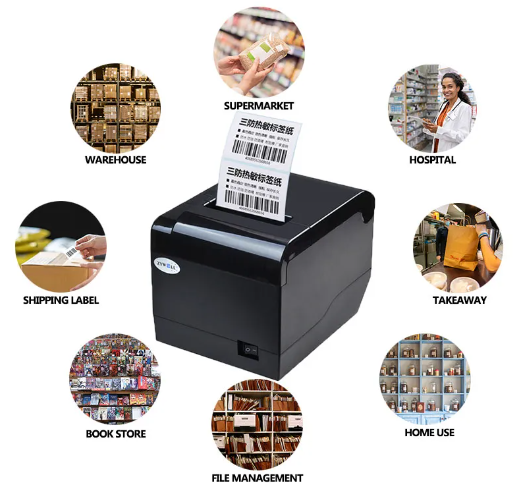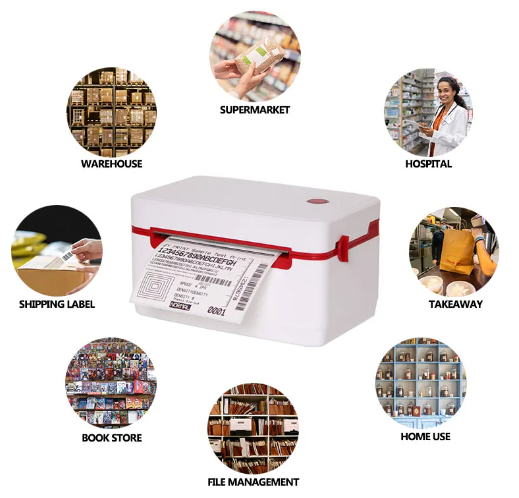The Comprehensive Guide To Selecting The Best Thermal Label Printer
When it comes to selecting the best thermal label printer, you're making a decision that will directly impact your business's efficiency, accuracy, and bottom line. Whether you're labelling products, shipping packages, or managing inventory, the right thermal sticker printer can save you time and money while improving the overall quality of your work. In this comprehensive guide, we'll break down everything you need to know to choose the right thermal sticker printer for your specific needs. Let's dive in.
Thermal Label Printers
Thermal label printers are specialized devices designed to produce labels using heat-sensitive materials. Unlike traditional printers that rely on ink or toner, thermal printers use a heated print head to create images on the label material. This method is not only faster but also more cost-effective for businesses that require high-volume label printing. The lack of ink cartridges means you save money on consumables, and the speed of printing can significantly enhance your operational efficiency.
Types of Thermal Label Printers
When it comes to thermal sticker printers, there are two main types: Direct Thermal and Thermal Transfer. Understanding the differences between these two can help you make a more informed choice.
● Direct Thermal Printers: Direct thermal printers use heat-sensitive paper that blackens when heated by the print head. This method doesn't require any ink, toner, or ribbon, making it highly cost-effective. However, direct thermal labels are more susceptible to fading when exposed to heat, light, or abrasion, making them ideal for short-term applications like shipping labels and receipts. They’re perfect for environments where labels are used and discarded quickly.
● Thermal Transfer Printers: Thermal transfer printers, on the other hand, use a ribbon coated with ink that melts onto the label material when heated by the print head. This method produces more durable labels that can withstand harsh environments, including extreme temperatures and chemicals. If your labels need to last for a long time or be resistant to fading, thermal transfer is the way to go. They’re commonly used for product labeling, asset tracking, and any application where label longevity is crucial.
Key Components of a Thermal Label Printer
To fully grasp how thermal sticker printers work, it's essential to understand their key components. The print head is the heart of the printer, responsible for transferring heat to the label material. Its quality and durability directly affect the print quality and the lifespan of your printer. Then, there's the ribbon (in thermal transfer printers) and media (labels), which play a critical role in determining the final output. High-quality ribbons and media ensure crisp, clear labels that last longer.
Additionally, the rollers help move the labels through the printer, and cutters, if available, slice the labels to the desired size. Choosing a printer with high-quality components ensures reliability, reduces maintenance needs, and delivers consistently excellent print results.
Key Considerations For Selecting The Best Thermal Label Printer
Here are the crucial aspects you need to weigh before making your choice—each one playing a vital role in determining the best thermal label printer for your business needs.
Print Speed and Volume Capacity
One of the first things you need to consider when choosing a thermal label printer is the print speed and volume capacity. Print speed is typically measured in inches per second (IPS) and refers to how quickly the printer can produce labels. If your business requires high-volume printing, opting for a printer with a higher IPS will ensure that you can meet demand without bottlenecks.
● Understanding Print Speed: Faster print speeds mean higher productivity, which is crucial for businesses that need to print hundreds or thousands of labels daily. However, it's important to strike a balance—higher speed often comes at the cost of print quality. Therefore, you need to assess your priorities: speed versus clarity. Generally, printers with a speed of 6 to 12 IPS are adequate for most businesses.
● Volume Considerations: It's also essential to match the printer's volume capacity with your daily printing needs. Entry-level printers might be sufficient for small businesses with low printing demands, while high-performance models are better suited for large-scale operations. Choosing the right volume capacity ensures that your printer doesn’t wear out prematurely, saving you from costly repairs or replacements.
Print Quality and Resolution
Print quality and resolution are critical factors, especially if your labels contain barcodes, small text, or intricate designs. The print resolution is measured in dots per inch (DPI), and a higher DPI means sharper, more detailed images.
● Importance of DPI (Dots Per Inch): A minimum resolution of 203 DPI is generally sufficient for basic labeling needs, such as shipping labels. However, if you need to print small fonts or detailed graphics, opting for a printer with 300 DPI or even 600 DPI will ensure that your labels are clear and easy to read. This is particularly important for barcodes, where readability directly impacts scanning efficiency.
● Matching Print Quality with Application Needs: Not every application requires the highest resolution. For example, a 203 DPI printer might be perfect for simple text labels, while a 300 DPI printer is better suited for product labels that require more detail. By matching the print quality to your specific application needs, you can achieve the best balance of cost and functionality.
Connectivity and Integration Options
In today's digital age, the ability to connect and integrate your thermal label printer with existing systems is crucial.
● Wired vs. Wireless Connectivity: Wired connections, such as USB or Ethernet, offer stable and fast data transfer, making them ideal for high-volume printing environments. On the other hand, wireless connectivity options like Wi-Fi and Bluetooth provide more flexibility, allowing you to place the printer anywhere without worrying about cables. This is particularly useful in dynamic workspaces where mobility is key.
● Integration with Existing Systems: Ensuring that your printer can easily integrate with your current POS systems, ERP software, or other business applications is vital. Many modern printers come with software drivers that facilitate seamless integration, but it's always a good idea to check compatibility before purchasing. The easier it is to integrate the printer, the smoother your operations will be.
Durability and Build Quality
The durability and build quality of a thermal sticker printer can significantly impact its longevity and performance.
● Material Considerations: Most thermal printers are made from either metal or plastic. Metal housings offer superior durability and are better suited for harsh environments, while plastic models are lighter and more portable. Depending on your workplace conditions, you’ll need to choose a material that can withstand daily wear and tear.
● Environmental Considerations: If your printer will be used in a dusty, humid, or temperature-variable environment, choosing a model that can resist these conditions is essential. Some printers are specifically designed to operate in challenging environments, ensuring consistent performance no matter the circumstances.
Ease of Use and Maintenance
A user-friendly thermal sticker printer can save you time and reduce frustration.
● User-Friendly Interfaces: Look for thermal sticker printers with intuitive control panels and easy-to-navigate menus. A well-designed interface minimizes the learning curve, allowing your team to get up to speed quickly. Some printers also come with touchscreen displays, making it easier to adjust settings and monitor the printing process.
● Maintenance Requirements: Regular maintenance is key to ensuring your printer's longevity. Features like easy access to the print head for cleaning, straightforward ribbon replacement, and simple media loading can make a big difference in reducing downtime. Choosing a printer with low maintenance requirements can save you time and money in the long run.
Conclusion
Choosing the right thermal sticker printer is more than just a technical decision—it's a strategic move that can elevate your business's efficiency and productivity. By understanding the key features, assessing your specific needs, and comparing top models, you position yourself to make an informed choice that benefits your operations in the long run.
As you finalize your decision, remember that the best thermal sticker printer for you is one that aligns with your business goals, meets your daily demands, and offers reliability for years to come. Take your time to evaluate all options, request demos, and consider after-sales support to ensure your investment is sound.
For more detailed information and to explore a range of top-quality thermal label printers, visit Zywell's official website. They offer a variety of models and resources to help you find the perfect fit for your business needs.

Zhuhai zywell is a printer manufacturer and comprehensive high-tech enterprise integrating POS printer design, research and development, production, sales and service.
CONTACT DETAILS
If you have any question, please contact us.

















